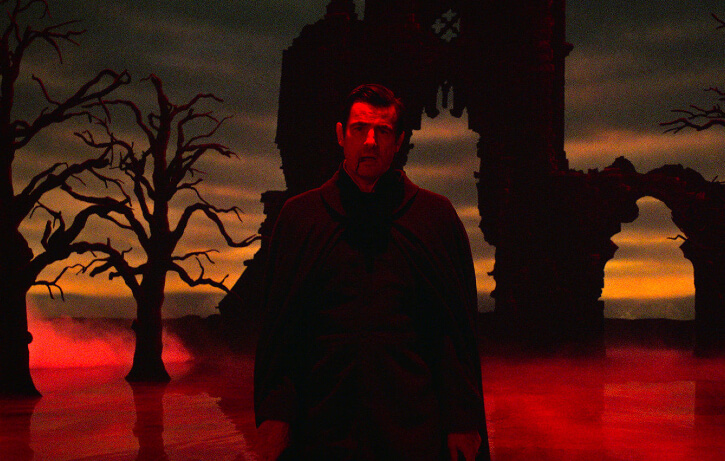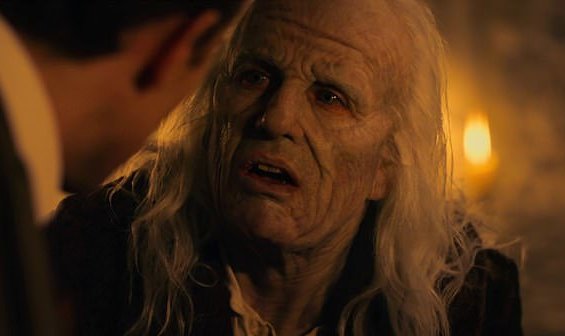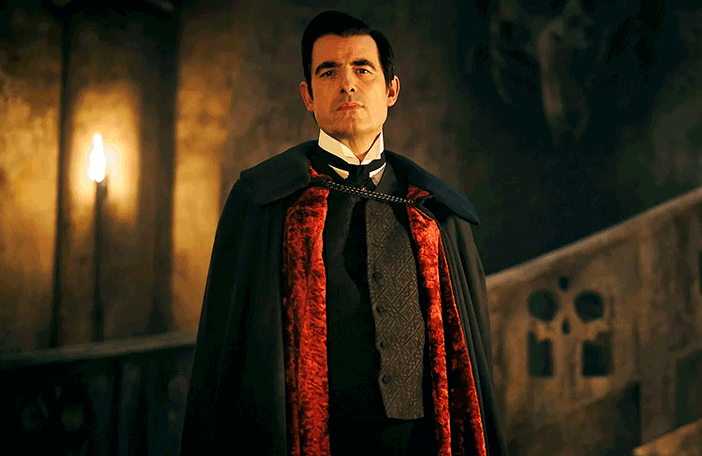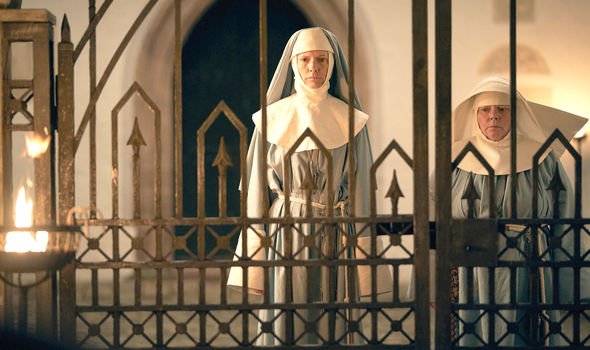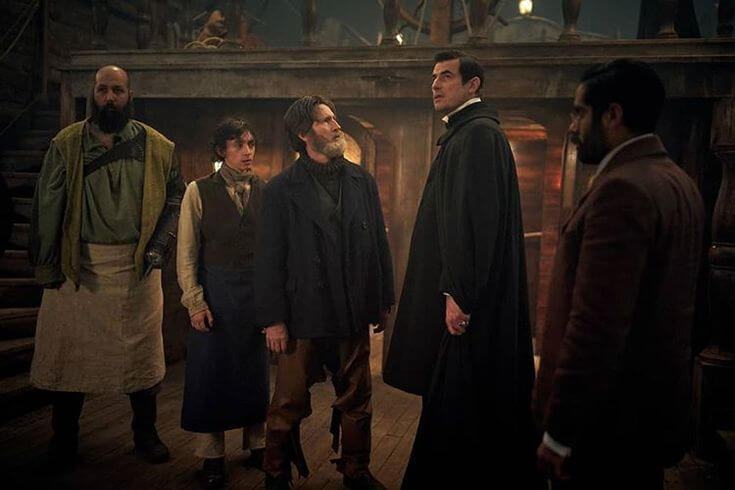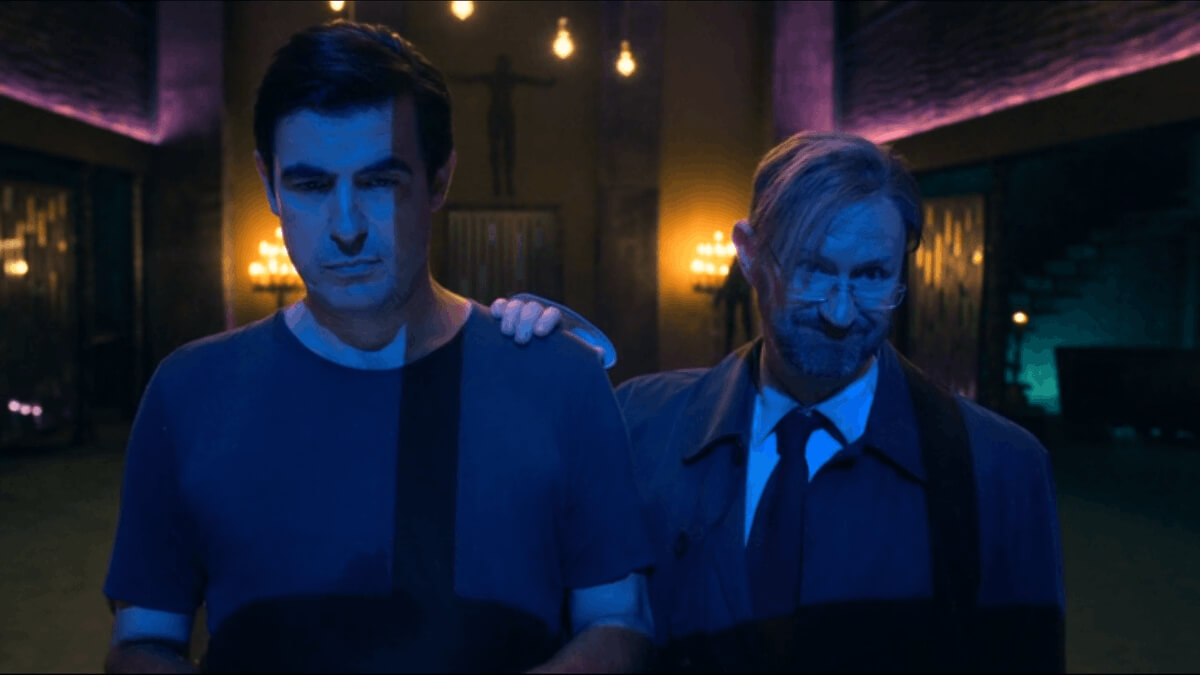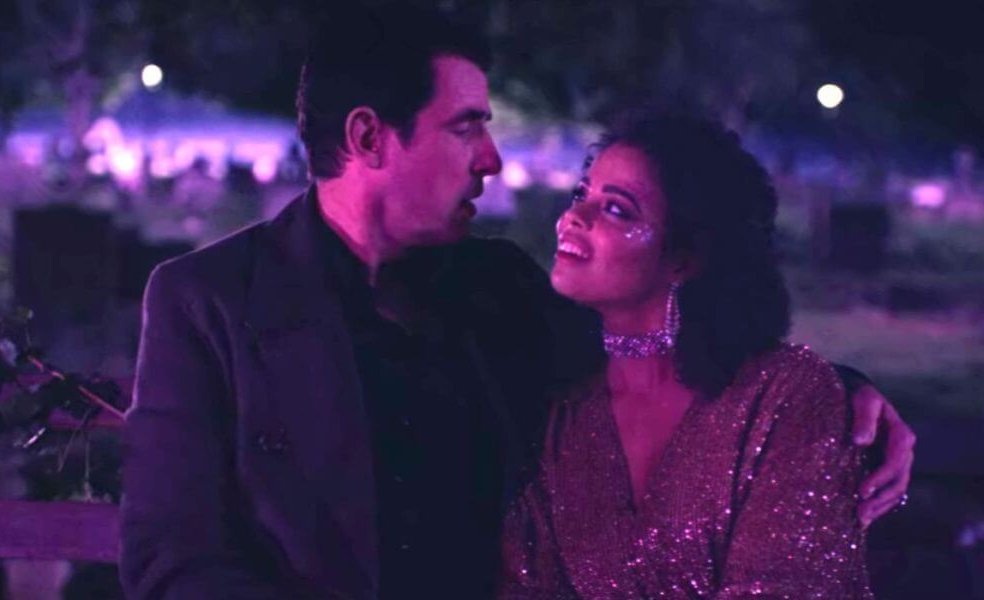The BBC’s three-part adaptation of Dracula, written by Steven Moffat and Mark Gatiss, did not air very long ago at all — just last year, in fact. However, it aired in the January of last year. This places it in the slice of 2020 termed pre-pandemic: an already antediluvian era that must surely be due its own wave of nostalgia. With that in mind, Halloween 2021 seems a good time to look back at Dracula 2020, a product of a time that has already been confined to history.
There was a time when both Moffat and Gatiss were associated primarily with comedy. The former was known for the relationship-based humour of Coupling, the latter for the unhinged pantomime of The League of Gentlemen. But then came the Doctor Who revival, which had Moffat and Gatiss as regular contributors from 2005 to 2017 (Moffat acting as showrunner for more than half of that period). Here, the two men earned themselves positions as custodians of British cultural icons. Moffat wrote the 2007 series Jekyll; Gatiss began adapting M.R. James’ tales for a revival of the BBC’s A Ghost Story for Christmas strand; and — thoroughly obscuring all of this — the pair collaborated on the TV sensation that was Sherlock, airing from 2010 to 2017.
With Victorian literature’s most illustrious hero covered, the era’s most famous villain was the natural follow-up. And so Dracula hit the screens, divided into a trilogy of 90-minute episodes (like a Sherlock season) and arriving close enough to the festive season to qualify as, if not quite A Ghost Story for Christmas, then at least A Vampire Story for New Year’s.
From the start, the series was faced with the challenge shared by anyone who tries to adapt Bram Stoker’s well-thumbed novel: coming up with a fresh take. Even relocating the story to the present day — the main selling point for Sherlock — is old hat for the Count, as testified by Hammer’s notorious Dracula A.D. 1972. How did Moffat and Gatiss confront this hurdle? Audiences found out when they sat down on 1 January to watch the debut episode of Dracula: “The Rules of the Beast”.
Dracula revived
One technique used by this first episode to distinguish itself from earlier adaptations of Dracula is to emphasise, and elaborate upon, lesser-remembered elements from the novel that tend to be left out of screen versions. A major example of this is the character of Sister Agatha, who takes care of Harker after he escapes from hospital. In the novel she is a negligible character, her most significant contribution being to send a letter to Mina Murray about the state of her fiancé:
He has told me all about you, and that you are shortly to be his wife. All blessings to you both! He has had some fearful shock—so says our doctor—and in his delirium his ravings have been dreadful; of wolves and poison and blood; of ghosts and demons; and I fear to say of what. Be careful with him always that there may be nothing to excite him of this kind for a long time to come; the traces of such an illness as his do not lightly die away. We should have written long ago, but we knew nothing of his friends, and there was on him nothing that any one could understand. He came in the train from Klausenburg, and the guard was told by the station-master there that he rushed into the station shouting for a ticket for home. Seeing from his violent demeanour that he was English, they gave him a ticket for the furthest station on the way thither that the train reached.
Small wonder, then, that screenwriters have typically had little use for her. Moffat and Gatiss, however, use Harker’s time with Agatha as a framing device for flashbacks to his imprisonment in Dracula’s castle. As a result, it is Agatha rather than Mina who becomes the story’s female lead.
There are other cases of the episode amplifying the obscure. Stoker’s Dracula starts the novel as an elderly man, but rejuvenates upon drinking blood; the film adaptations (the most notable exception being the 1992 version starring Gary Oldman) typically ignore this potentially cumbersome detail. Moffat and Gatiss, however, not only use it but expand upon it: this Dracula absorbs the properties of his victims, obtaining Harker’s accent as well as his youth. Still another oft-overlooked detail from Stoker is the bizarre scene in which Dracula disguises himself in Harker’s clothes; Moffat and Gatiss translate this into an effective body-horror centrepiece, with their Dracula able to wear a victim’s skin as a disguise.
While it undeniably takes a lot of liberties (and rejects much of Stoker’s dialogue) the first hour or so of “The Rules of the Beast” is no less faithful to its source than most of the earlier adaptations. The much-loved 1958 Hammer version with Christopher Lee, for one, played remarkably fast and loose with the text: it changed Harker from an unsuspecting victim to an agent who was plotting to slay Dracula all along, then killed him off, and then removed the portions of the novel set in England. This resulted in a close, claustrophobic retelling that appears to have been a major influence on “The Rules of the Beast”
.
Granted, many of the alterations made by Hammer likely arose from limitations of runtime and budget. However, on another level, the creative team were — like Moffat and Gatiss — making a self-conscious reinvention of a character who had become a bit of a joke. Terence Fisher, who directed the 1958 film, is quoted as acknowledging this in Alan Frank’s book Monsters & Vampires:
The first time Dracula is seen, at the top of the staircase in silhouette, the audience, the ones you want to laugh, start to laugh, because they think they’re going to see the fangs and everything else. Dracula comes downstairs, into close-up and they see this handsome, charming and totally attractive man.
Although his later typecasting would obscure this virtue, Christopher Lee’s turn as Dracula once had all the novelty value of Benedict Cumberbatch’s debut as a Sherlock Holmes.
In re-introducing the character of Count Dracula to audiences, Moffat and Gatiss appear to have had a similar philosophy to Fisher — although they were also willing to delay the effect. Danish actor Claes Bang stars as Dracula, and he makes his initial appearance under layers of old-age make-up and a faux-Transylvanian accent. The general effect, it has to be admitted, is risible; and it is easy to imagine that a not-insignificant portion of the audience turned off in contempt at the latex-coated Bang croaking across the screen. (Granted, many had a similar reaction to Gary Oldman, but at least his Dracula boasted an admirable costume and hairstyle).
However, as with the other famous villains reinvented by Steven Moffat — the Master, Moriarty, Mr. Hyde — Dracula is a figure of multiple identities. His initial appearance as a cringeworthy cartoon is a disguise to be thrown off like one of the Master’s rubber masks when he tastes Harker’s rejuvenating blood. This is the point at which we finally meet the real 2020 Dracula as reinvented by Moffat, Gatiss and Bang.
Dracula redefined
The series is quick to establish that Dracula has a sense of humour — a deadpan, ghoul-camp sense of humour. He objects to being surrounded by “people without flavour” and reassures Harker that “there’s no-one… living here” (needless to say, Bela Lugosi’s famous “I never drink… wine” gets an encore). But the humour is never at the expense of the character, who oozes self-confidence.
This Dracula belongs to a sphere of swaggering, manipulative and smart-mouthed villains who have long been a fixture in SF/F television. Q from Star Trek: The Next Generation popularised antagonists of this type, while the villains in Buffy the Vampire Slayer — particularly Spike — provided variations on the theme. The character type has a more upmarket pedigree, as well: witness the fourth-wall-breaking devil played by Michael Kitchen in Dennis Potter’s 1976 TV drama Brimstone and Treacle. Moffat’s takes on Moriarty, Mr. Hyde and the Master are clear comparison points — although in the case of the Master it was Russel T. Davies, Moffat’s predecessor as Doctor Who showrunner, who pushed the character in a more Q/Spike-esque direction.
All that being said, Dracula is given three specific traits that help to distinguish him from the general morass of Q-alikes.
First, he comes across as something of a wheeler-dealer — a man who manipulates to further his business interests rather than out of a simple delight in manipulation as Sherlock‘s Moriarty did. The scene in which the estuary-accented Count dictates the terms of a crooked financial transaction to Harker looks like nothing so much as a Mark Gatiss-helmed reboot of Only Fools and Horses, Del Boy reimagined as a League of Gentlemen character.
The second trait is his sexuality. Dracula has always been a sexual being — his attack on Mina in the novel is hard to read as anything other than an analogue to rape — but different eras have different attitudes towards sexuality, and consequently different Draculas. Moffat and Gatiss make the Count overtly bisexual, referring to Harker as his “bride” and implying that he has had other male “brides” in the past. The episode’s handling of this trait borders on the gimmicky: when Agatha asks Harker if he had sexual relations with Dracula, this is deemed significant enough to be placed right at the end of the pre-credits sequence.
As the story unfolds, the Count’s bisexuality turns out to have little importance beyond making his imprisonment of Harker just that little more psychologically abusive. Steven Moffat has gone on record as saying that Dracula is “bi-homicidal” rather than bisexual: “He’s not actually having sex with anyone. He’s drinking their blood… You might need to delete your Tinder if that is what you think. Dracula has always fed off men and women.”
On the surface, Moffat’s humorous remarks might seem disingenuous. After all, the relationship between a vampire and their prey has long been coded as sexual or even romantic, as evidenced by the vast vampire romance subgenre. At the same time, however, Bang’s Dracula would never be mistaken for Edward or Angel, or even Gary Oldman’s pining Count. His “brides” are disposable playthings. Most become grotesque, bestial, zombie-like creatures in the castle vault; even Harker, who retains his personality, ends up serving the same purpose as the novel’s Renfield: a tool for Dracula to reach more victims. Dracula may be sexual, but — crucially — he is not romantic. His sexuality is warped into something monstrous and destructive.
(As an aside, Moffat is quite right when he asserts that Dracula has always prayed upon both men and women. While most of the vampire attacks in Stoker’s novel — including all those described in detail — are heterosexual, the Count does kill the male crew of the ship that transports him to England.)
The third trait of note, and the one that turns out to be the most significant across the three-episode series, is that Dracula is a figure of mystery.
Mysteries have characterised much of Moffat’s post-Coupling series. Sherlock is the obvious example, but his run on Doctor Who was also built around intricate-to-ramshackle puzzle-box narratives. The most relevant comparison to Dracula, however, is Moffat’s handling of Jekyll. At the time of its publication in 1886, Robert Louis Stevenson’s Strange Case of Dr Jekyll and Mr Hyde would have been received by readers as a mystery narrative, as the relationship between the two title characters was not revealed until the final chapter. With the duo having passed into proverb, of course, this mystery no longer works for modern audiences, and so Moffat penned a sequel narrative with a new mystery.
Jekyll followed a man who found that Stevenson’s story was based on true events and that he was a descendant of Dr. Jekyll; however, he also found that the potion responsible for turning Jekyll into Hyde was Stevenson’s invention, raising the question of what really created Hyde. (Other mysteries, most notably those pertaining to a well-equipped conspiracy against the protagonist, also played a part). The plot of Dracula poses a similar problem. Although Stoker’s novel could be termed a mystery narrative — with the characters first deducing the nature of Dracula, and then the means of killing him — a modern retelling will have to either forego this aspect of the story, or else invent new mystery.
From the start, Moffat and Gatiss show an eagerness to bring an aspect of puzzle-solving to a narrative long shorn of its surprises. We see this when the first episode introduces a character with no basis in the novel: Petruvio the Widower, a long-dead architect credited with designing Dracula’s intricate castle. The story establishes that Petruvio included hidden areas in the building, and Harker must follow a series of clues touching upon the architect’s relationship with his wife to locate the secret corridors and chambers.
The biggest puzzle, however, is Dracula himself. “The Rules of the Beast” clearly establishes that the Count’s various weaknesses are not simply a jumble of superstitions but have a shared reason for existing, as spelt out by Sister Agatha:
None of the vampire legends make sense, and yet somehow they are proving to be true. He can’t enter a home without being invited. Why not? The light of the day would burn him to death. Why? He’s terrified of the cross, and yet he’s no believer. Somehow, these facts are all the same fact. There’s one thing that Dracula fears above all and, to destroy him… we must discover it.
This is set up as the puzzle that will be pieced together over the course of the three episodes. It could be argued that there is another puzzle being assembled at the same time — namely, the question of which elements from the novel will be transferred and which will be abandoned.
In its final third, “The Rules of the Beast” departs both from Stoker and from the tradition of loose Stoker adaptations with an entirely original sequence in which Dracula attacks the convent where Jonathan Harker is held. Harker — by now reduced to a decaying husk — is sidelined; Sister Agatha, who previously existed primarily as someone to hear Harker’s story, takes over as protagonist. Her newfound importance is heralded when we learn that her full name is Agatha Van Helsing.
Pop culture has done much to elevate the character of Abraham Van Helsing. in Stoker’s novel, he was simply the first member of the ensemble cast to consider the possibility that Dracula is a vampire and to conduct the necessary research. His cinematic manifestations from Peter Cushing through to Hugh Jackman reshaped him into a dashing, vampire-slaying hero, a Holmes to Dracula’s Moriarty. By the time the 2020 Dracula rolled around, things had long since reached the point where simply appending the surname “Van Helsing” to a character was enough to grant them narrative weight.
The ensuing battle of wills between Dracula and Agatha Van Helsing is one of the standout sequences in the series. everything comes together — Moffat and Gatiss’ writing, Jonny Campbell’s direction, the performances by Bang as Dracula and Dolly Wells as Agatha. The set-up oozes with iconic overripeness, the wimpled nuns pitted against a Count who, having transformed into a wolf and back, is naked. At the centre of it all is a simple conceit: Dracula is unable to enter the convent without being invited, rendering all of his infernal powers worthless unless he is able to obtain an invitation via intimidation or trickery.
This is an inspired position to put him in. A key aspect of the Q-type antagonist is their (literally or figuratively) godlike level of control over their fictional world. They often sidle up to the fourth wall, giving the impression that they transcend the narrative conventions binding their opponents (as Moffat’s version of the Master put it: “I am that mysterious adventurer in all of time and space known only as Doctor Who, and these are my disposables, Exposition and Comic Relief”). Putting a villain of this type into a place where his goal is tantalisingly out-of-reach — where the rules of the narrative come back to bind him — makes for an ideal climax. While the bisexual gimmickry and cartoonish Old Dracula may bog down “The Rules of the Beast” at first, the episode nonetheless ends as a triumph.
Dracula returns
The second episode, “Blood Vessel”, again homes in on a relatively obscure part of Stoker’s novel: this time, the brief (if memorable) sequence in which Dracula stows away on board a ship and picks off the crew prior to arriving in England. This part of the story was truncated by Universal and omitted by Hammer, but Moffat and Gatiss devote the entire middle third of their adaptation to it.
Fleshing out the thin source narrative, the writers come up with an all-new set of characters from various walks of life: a superstitious ship’s mate; a nervous cabin boy; a gruff cook; an Indian doctor and his deaf-mute daughter; a German grand duchess; a pair of English aristocrats and their resentful African manservant; plus Dracula himself, who this time travels openly as a passenger rather than stowing away in a box. The general atmosphere is closer to Agatha Christie than to Stoker; but as making a whodunit out of Dracula’s killings would be impossible, the episode finds room for additional mysteries.
Who is the bedridden occupant of the forbidden cabin number nine? What events led up to the presumably in medias res framing device, where Dracula narrates his story to Agatha Van Helsing over a dignified game of chess? What are the machinations going on between the various passengers, some of whom turn out to have prior connections to Dracula? All of these puzzles are set up over the course of the episode and then solved before its end: once again, we have Dracula reimagined as Sherlockian mystery drama, with multiple enigmas per instalment.
As we see these mysteries solved one by one, “Blood Vessel” turns out to share a large amount of its structure with the first episode. Once again, the framing scenes where the story is narrated past-tense to Agatha collide into the narrative’s present; and once again, the climax is built around Dracula menacing a group of people behind a protective barrier — indeed, the Count even points out the similarities here. The episode is able to get away with this repetition, however, on the strength of the characters it has built up. The passengers on board the ship all have well-delineated perspectives: for example, the doctor has past experience with vampires; the male aristocrat wishes to become a vampire; and the manservant is a hard-headed skeptic who dismisses talk of vampires as nonsense. Between them, these characters make a rather more volatile set of would-be victims than the convent of nuns in “The Rules of the Beast”.
“Blood Vessel” plays well. Much of it feels like something that Hammer’s Dracula cycle might well have reached had the studio survived long enough to hit upon “Bram Stoker meets Agatha Christie” as a pitch. Then came the third of January, and the third and final episode: “The Dark Compass”.
This covers Dracula’s arrival in England — specifically the England of 2020, as he was stranded underwater for more than a century. The switch from the neo-Hammer nineteenth century of the first two episodes to a Sherlockian modern-day setting may sound gimmicky on paper, but it is quite true to the source material: after all, Stoker’s novel was about a vampire escaping from a fantastical Ruritania into contemporary Britain. Moffat and Gatiss’ time-jump is one of the few ways this can be convincingly recreated in a modern adaptation.
After sending Dracula to the twenty-first century, the two writers give themselves some solid material to work with. The Count ends up a captive of the Jonathan Harker Foundation, a medical research organisation founded by members of the Van Helsing family and presently run by one Zoe Helsing (again played by Molly Wells). The monster-in-a-research-facility set-up is a familiar one: Moffat used it in Jekyll, Gatiss employed something similar in Sherlock‘s “The Hounds of Baskerville”, and in the context of British vampire television alone it goes at least as far back as Ultraviolet from 1998. On top of this tried-and-true setting, the episode still has large chunks of Stoker’s novel left to adapt, including multiple major characters absent from the first two instalments.
Yet despite having all of the ingredients for a satisfying finale, “The Dark Compass” is where things unravel.
Dracula retreats
The most immediately noticeable issue is the episode’s scattershot tone. An early scene in which Dracula shows a childlike fascination with light-switches after cramming the homeowner into his own fridge is a natural extension of the black humour found in the first two episodes; but the sequences portraying much of Stoker’s mortal cast (Jack Seward, Lucy Westenra and Quincey Morris) as nightclubbers appear to have been lifted from a teen soap opera. Meanwhile, the plot device in which Dracula escapes from the research facility by hiring a lawyer (Mark Gatiss, playing a comical interpretation of Renfield) via Skype can only be described as outright camp. None of these disparate tones quite cohere.
Another shortcoming is that episode three — unlike “Blood Vessel” — has trouble developing much of its new cast. Quincey Morris, who in the novel was one of the two men to kill Dracula, is reduced to an Easter egg: even Lucy’s gay friend Zev, an original character, is given a larger role in the story. Junior Doctor Jack Seward is too thinly developed to leave much impression, despite being the secondary protagonist to Zoe Helsing and one third of a doomed love triangle with Dracula and Lucy.
The general impression of all this is that Dracula — a series so much about control — has itself lost control. Despite its weaknesses, however, the episode does have one truly successful plot thread running through its core in Dracula’s courting of Lucy. Stoker’s tragic heroine is played by Lydia West as a blank slate ready for Dracula’s influence: she might even be described as a wide-eyed innocent, were it not for her morbid tendencies. Had she been less popular at school, she might even have become a Goth.
Like any Goth couple worth its salt, the pair’s idea of a romantic night out takes place at the local cemetery. Here, Dracula reveals to Lucy that many of the graves are inhabited by the undead; not vampires, simply “the unfortunate few who remain sentient as they rot” (this idea was seeded by Sister Agatha in the first episode: “As their bodies rot, their consciousness persists. Even as dust, their pain goes on. It is a secret every gravedigger keeps”). He then allows her to hear the voices of the dead. One calls for help; another simply counts; still another — a child who speaks in cooing babytalk — calls Lucy a “bloofer lady”.
Dracula’s next move is to turn Lucy into a vampire. She eventually rises from her coffin, but only after being cremated: consequently, her undead form is hideously disfigured by burns. Yet when she sees her reflection she appears still beautiful; still the bloofer lady. Only when she sees a photograph of herself does she realise the terrible truth.
It is tempting to speculate that Steven Moffat is dealing with a personal phobia here. One of his 2014 Doctor Who episodes also posited that corpses can remain sapient, and can feel pain when cremated. The episode prompted a deluge of complaints on the grounds that such a notion was too disturbing for family television. With Dracula, Moffat is able to explore the genuinely nightmarish concept in more detail; the results may not be faithful to the letter of the source novel, but they are certainly true to its spirit. The episode’s Lucy plot thread captures the weirdest attributes and the most gruesome charnel-house trappings of Stoker’s vampires, amply demonstrating what a modern update of Dracula can achieve.
This leaves the episode with the final confrontation between Dracula and Zoe Helsing — which is, alas, rather less successful.
Here, the series clears up its much-toted mystery as to the cause of Dracula’s weaknesses. In figurative terms, this amounts to giving him an origin story, which is something that many past writers have tried. Stoker posited that the Count was a graduate of Scholomance, a school of the black arts found in Transylvanian legend, but somehow this part of the story failed to stick in later retellings. The Gary Oldman Dracula of 1992 was depicted as a tragic figure who had forsaken God and turned to the Devil after the suicide of his beloved wife. Eight years later came Dracula 2000, which revealed that the Count is none other than Judas Iscariot — hence his fear of crosses and silver. Paul Witcover’s 2006 novel Dracula: Asylum also uses the Judas origin, but not before offering a still more provocative twist on the New Testament by suggesting that Dracula is actually Jesus, corrupted by humanity’s sins.
Moffat and Gatiss head in a very different direction and spend their finale abandoning Gothic fantasy altogether. There are no historical tragedies here; no schools of diabolism, no punishments for blasphemous transgression, no gods or devils. Instead, all of Dracula’s weaknesses are revealed to be psychological in origin, stemming from his self-hatred. His superpowered sidelined, this Dracula could easily have been one of the archvillains in Sherlock.
The series’ conclusion does more than just kill Dracula. It does a meticulous job of dissecting his body, reducing him to a set of symbols that are neatly explained to the audience. Nothing is left to the imagination — and a vampire is nothing without the imagination. While Moffatt, Gatiss and Bang have all expressed interest in mounting a second season of Dracula, it is hard to imagine the series regaining life after so thoroughly dismantling the character it spent hours building up.
Dracula reconsidered
When a story’s weaknesses turn up towards the end, this has the effect of obscuring the strengths found earlier on — and the 2020 Dracula most certainly has its share of strengths. Its two period episodes recreate the spirit of Hammer without taking the easy route of self-parody. Its emphasis on lesser-known areas of Stoker’s novel allows it to stay fresh while maintaining a degree of fidelity. It is able to veer from black comedy to full-blooded horror without the one aspect detracting from the other. Its main strength, meanwhile, is its portrayal of Dracula himself.
This Dracula cracks jokes, but seldom becomes a joke; he retains a layer of sexuality without turning into a wistful lover. Were it not for the Halloween costume Old Dracula at the very start and the therapy session at the very end, he would have avoided all of the pitfalls that come with re-interpreting Stoker’s Count. He is, in short, a Dracula who warrants serving as the central character of a four-and-a-half hour drama.
We may never see a retelling of Dracula that stands in the cultural imagination alongside the versions starring Max Shreck, Bela Lugosi, Christopher Lee and Gary Oldman. It may well be that public tastes (and habits of media consumption) have evolved to the point where there is simply no room for another new Dracula as anything other than a curiosity on the side. If there were ever a fifth face added to that Carpathian Rushmore, however, then the Dracula created by Steven Moffat, Mark Gatiss and Claes Bang would be a worthy candidate for the honour.

